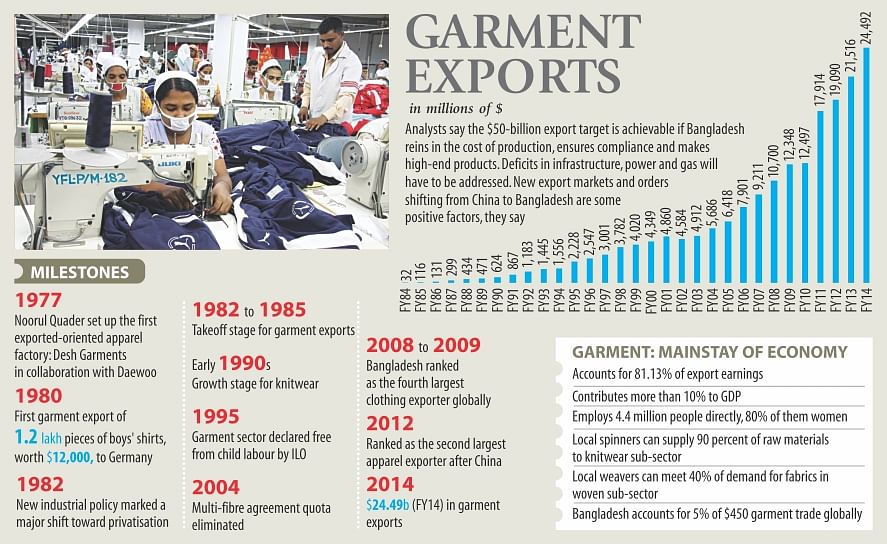From baby steps to giant strides
From baby steps to giant strides

It was a small beginning 35 years ago, but today it is a huge success story that brought Bangladesh global fame as a major garment exporter. The country that began a new era of apparel shipments with basic and low-end products has now diversified its export basket with many high-end and specialised garment items.
The examples of diversification are aplenty. Bangladeshi apparel makers now supply uniforms to the British army and French navy and defence personnel of many other nations, which proves the sector is quite mature and strong.
The information might be amazing to many that Bangladeshi factories made uniforms for the Nato military personnel who were deployed in Afghanistan war a few years ago.
The sector's journey spanning three decades and a half has made the country a hub of almost all apparel products -- basic, high-end and specialised items, for both medium and upscale retailers.
The country also exports tents, fire-hydrant garment products and sleeping bags.
Now, 30 percent of the total garment exports, which started booming in 1990s on the back of higher quota utilisation, are high-end. At the beginning, Bangladesh used to manufacture basic items like T-shirts, shirts and trousers.
Resilient entrepreneurs proved wrong the doomsayers who had predicted that Bangladesh's garment business would collapse after the elimination of a quota system on December 31, 2004. Rather, garment exports grew 16.48 percent a year, on average, since the end of the quota system.
Now, Bangladesh eyes $50-billion apparel exports by 2021, when the country will celebrate the 50th anniversary of its independence. Khondaker Golam Moazzem, additional director (research) of the Centre for Policy Dialogue, said the target is a bit ambitious, but setting such a great target is a positive step.
To reach the target in seven years from the current $24.5 billion, apparel shipment will have to maintain a 15-20 percent growth year-on-year, which is difficult, he said.
“But, at the same time, Bangladesh has developed some new export destinations like Japan, India, China, Turkey, Russia and Latin American countries. These factors are positive for the country,” he said.
The shift of work orders from China to Bangladesh is a major factor, but many other countries are also receiving such orders, he said. Moazzem said Bangladesh will have to contain the cost of production, ensure compliance and make high-end goods to reach the target.
Bangladesh's garment exports rose 13.86 percent year-on-year to around $24.5 billion in fiscal 2013-14. The export target for this fiscal year has been set at $26.90 billion.
Industry insiders attributed the growth to a skilled and industrious workforce and a good number of dedicated entrepreneurs.
Bangladesh is the second largest garment exporter after China. Not only that, the sector created jobs for 4.4 million people, 80 percent of them being migrated rural women.
The sector people said Bangladesh will need to grab 8 percent of the global apparel business worth $450 billion -- up from the present level of 5 percent -- to hit the $50-billion milestone.
They said the global business will reach $650 billion by 2021 with more demand from the EU, the US, Far Eastern countries and India.
McKinsey & Company, a global management consultancy firm, predicted that Bangladesh will be able to export $44.56 billion worth of garment products by the end of 2020.
Some of the high-end fashion brands such as Hugo Boss, Puma, Tommy Hilfiger, G-Star, Diesel, Ralph Lauren, Calvin Klein, DKNY, Nike, Benetton and Mango have been outsourcing garment products from Bangladesh over the last few years.
The $50-billion export target is achievable if the issues such as infrastructure, power and gas are addressed and the government formulates policies in a planned way, said Kutubuddin Ahmed, a former president of Bangladesh Garment Manufacturers and Exporters Association.
Ahmed, the chairman and founder of Envoy Group, started his business in 1984 with only 200 workers. He is now one of the major garment exporters in the country employing around 22,000 workers.
David Hasanat, chief executive of Viyellatex Group, another leading exporter, also echoed the views of Ahmed. “Achieving the target is very much possible.” The retailers are increasingly shifting work orders to Bangladesh from China, he said.